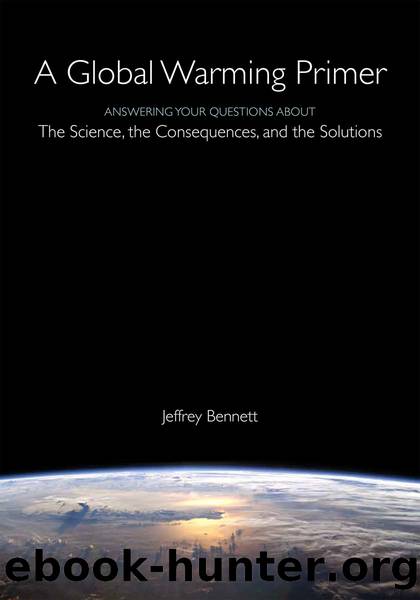A Global Warming Primer by Jeffrey Bennett

Author:Jeffrey Bennett
Language: eng
Format: epub
Publisher: Big Kid Science
Published: 2016-10-15T00:00:00+00:00
Q OK, but maybe the models are missing an important mitigating factor. For example, arenât there uncertainties about the effects of clouds?
Itâs true that clouds are very complex and their effects are still not fully understood. This fact opens the way for a skeptic argument that basically goes like this: Global warming means the world starts getting warmer, and this increases evaporation from the oceans, which in turn means more clouds, which in turn reflect more sunlight, thereby stopping further warming. In other words, the claim is that clouds represent a negative feedback that acts to prevent global warming from getting too bad.
The problem with this argument is that it ignores two other effects. First, the additional evaporation that leads to the additional clouds also means there is more water vapor in the atmosphere, and recall that water vapor tends to amplify the effects of changes in the carbon dioxide concentration. While there is some legitimate debate over which effect â the extra heating from water vapor or the extra cooling from clouds â is stronger on relatively short time scales, there is little doubt about water vaporâs amplifying role over periods of decades or longer. Moreover, even for short time scales (years), current understanding of cloud physics has led most scientists to conclude that the heating effects are stronger than the cooling ones.
Second, clouds are not the only thing that matters here. What really counts is the total reflectivity of Earth: If the reflectivity increases, that tends to cool the planet, and if it decreases, it tends to warm it. And while clouds contribute to the total reflectivity, the surface also plays an important role, and global warming is causing the surface reflectivity to decrease, which tends to make the warming worse. The major reason for this decrease is the melting of ice, which is much more reflective than the water or ground cover that replaces it after it melts. For example, the fact that much of the Arctic ocean is now ice-free for much longer times each year than in the past means that this ocean reflects less sunlight (and therefore absorbs more), which leads to more heating.
Most climate scientists suspect that, together, the warming effects of added water vapor and reduced ice cover should overwhelm the cooling effects of additional clouds. So while you may still hear this argument raised on occasion, you should recognize that any claims that clouds will mitigate our problems are on very weak ground.
Download
This site does not store any files on its server. We only index and link to content provided by other sites. Please contact the content providers to delete copyright contents if any and email us, we'll remove relevant links or contents immediately.
The Secret History by Donna Tartt(18851)
The Social Justice Warrior Handbook by Lisa De Pasquale(12143)
Thirteen Reasons Why by Jay Asher(8799)
This Is How You Lose Her by Junot Diaz(6796)
Weapons of Math Destruction by Cathy O'Neil(6147)
Zero to One by Peter Thiel(5689)
Beartown by Fredrik Backman(5600)
The Myth of the Strong Leader by Archie Brown(5427)
The Fire Next Time by James Baldwin(5250)
How Democracies Die by Steven Levitsky & Daniel Ziblatt(5129)
Promise Me, Dad by Joe Biden(5088)
Stone's Rules by Roger Stone(5027)
A Higher Loyalty: Truth, Lies, and Leadership by James Comey(4846)
100 Deadly Skills by Clint Emerson(4840)
Rise and Kill First by Ronen Bergman(4705)
Secrecy World by Jake Bernstein(4648)
The David Icke Guide to the Global Conspiracy (and how to end it) by David Icke(4628)
The Farm by Tom Rob Smith(4439)
The Doomsday Machine by Daniel Ellsberg(4417)
